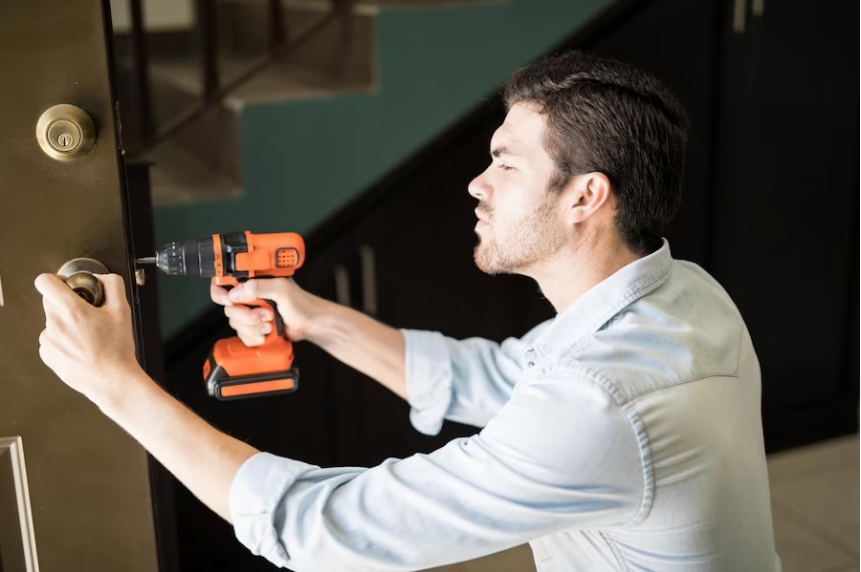Common Door Problems: Doors are more than just a functional piece of your home, they are also a symbol of transition and protection. As you walk through them, they provide a sense of security and comfort. However, when they don’t function properly, they can become a nuisance and even a safety hazard. That’s why it’s important to know the basics of fixing common door problems.
In this article, we’ll take you through the process of diagnosing door problems, lubricating squeaky hinges, fixing stuck or misaligned doors, repairing or replacing door locks, and maintaining door hardware for longevity. With our step-by-step instructions and helpful tips, you’ll be able to tackle common door problems with ease and restore the functionality and security of your home.
Whether you’re a seasoned DIYer or a beginner, this guide will provide you with the knowledge and confidence to take on any door problem that comes your way.

Diagnosing Door Problems
You’ll quickly identify any issues with your entryway by honing your diagnostic skills.
Start by checking the hinges. If your door is sticking or not closing properly, it could be due to loose or misaligned hinges. To fix this, tighten any loose screws and adjust the hinges until the door is level and swings smoothly.
If the hinges are damaged or rusted, they may need to be replaced entirely.
Another common issue with doors is air leaks. If you notice drafts or cold spots near your entryway, it may be due to worn or missing weatherstripping. Luckily, this is an easy fix.
Simply remove the old weatherstripping and replace it with a new strip, making sure to seal any gaps or cracks around the door frame.
With a little bit of attention and some basic tools, you can easily tackle these common door problems and keep your entryway functioning smoothly.
Lubricating Squeaky Hinges
Silence the annoying screeching with a little oil, as lubricating squeaky hinges will have your door opening and closing smoothly in no time. Choosing the right lubricant is crucial to ensure long-lasting results. You can choose from a variety of options like silicone spray, graphite powder, or a general-purpose lubricant. However, avoid using vegetable oil, motor oil, or any other heavy oil as they tend to attract dirt and grime, making the door problem worse.
Once you’ve chosen the right lubricant, it’s time to apply it to the squeaky hinges. Start by cleaning the hinges with a cloth to remove any dirt or debris. Then, apply the lubricant to the top of the hinge pin, letting it seep into the hinge. Move the door back and forth to help distribute the oil evenly. Remember to wipe off any excess lubricant as it can attract dirt and dust.
By following these tips for application, you’ll be able to fix squeaky hinges in no time, making your door operation smooth and soundless.
Fixing Stuck or Misaligned Doors
If your entryway is giving you trouble, don’t let it ruin your day – learn how to get it back on track with these simple tips.
A stuck or misaligned door can be frustrating to deal with, but with a little bit of know-how, you can easily fix the problem.
The first thing you should check is the hinges. If they’re loose or out of alignment, adjusting them can often solve the issue. Tighten any loose screws and try adjusting the hinges until the door opens and closes smoothly.
If adjusting the hinges doesn’t work, the problem may be with the door itself. Sometimes, a door can become stuck or misaligned due to swelling caused by changes in humidity. In this case, you may need to sand the edges of the door to make it fit properly in the frame. Use a fine-grit sandpaper and sand the edges carefully until the door fits smoothly in the frame.
With these simple tips, you can easily fix a stuck or misaligned door and have it functioning properly in no time.
Repairing or Replacing Door Locks
It’s important to ensure that your entryway is secure, and if you’re having difficulty with the locking mechanism, you may want to consider repairing or replacing it.
Upgrading your security measures can give you peace of mind and protect your home from potential intruders.
When it comes to repairing or replacing your door lock, there are a few things to keep in mind.
First, you’ll want to choose the right door handle. There are a variety of options available, including knob, lever, and deadbolt handles.
Knob handles are the most common, but they may not provide the level of security you need.
Lever handles are easier to operate, making them a good choice for those with mobility issues.
Deadbolt handles are the most secure, but they can be more difficult to install.
Consider your needs and preferences when choosing the right handle for your door.
Maintaining Door Hardware for Longevity
To make sure your door hardware lasts a long time, you’ll want to keep up with regular maintenance tasks. These include lubricating hinges and tightening screws.
Over time, hinges can become stiff and difficult to open or close. To prevent rust buildup and ensure smooth operation, lubricate the hinges with a silicone-based lubricant. Apply a small amount of lubricant to the hinge pin and work it in by opening and closing the door several times. Avoid using oil-based lubricants, which can attract dirt and dust and cause the hinges to stick.
Another important maintenance task is tightening loose screws. Over time, screws can become loose, causing the door to sag or making it difficult to close properly. Use a screwdriver to tighten any loose screws in the door hardware, including the hinges, latch plate, and strike plate.
Check the screws on a regular basis and tighten them as needed to prevent further damage to the door and hardware. By performing these simple maintenance tasks, you can extend the life of your door hardware and ensure that your doors operate smoothly and securely for years to come.
Common appliances problems: https://harmonytweets.com/simple-fixes-for-common-appliance-problems/
Frequently Asked Questions
How do I fix a door that won’t stay open or closed?
Having trouble with a door that won’t stay open or closed? The most common culprits are misaligned hinges or a sticky latch.
To fix the issue, you’ll need to adjust the hinges or lubricate the latch. Start by inspecting the hinges for any visible damage or wear. If everything looks good, try tightening the screws on the hinges to see if that helps.
If the problem persists, you may need to adjust the hinges by loosening the screws and moving the hinge slightly until the door sits correctly. If the problem is with the latch, try lubricating it with a silicone spray or graphite powder. This should help the latch glide smoothly and keep the door securely closed.
By taking these steps, you can quickly solve the problem and have your door functioning properly in no time.
What should I do if my door is sagging or dragging on the floor?
If your door is sagging or dragging on the floor, there are a few things you can do to fix the problem.
First, try adjusting the hinges. You can do this by loosening the screws on the hinge and shimming it with pieces of cardboard or wood until the door is level.
If this doesn’t work, you may need to lubricate the hinges with a silicone-based spray or oil. This will help the hinges move smoothly and reduce friction, which can cause the door to drag.
It’s important to be methodical and detail-oriented when fixing a sagging or dragging door, and to take your time to ensure that the problem is fully resolved.
Can I repair a cracked or broken door frame?
Repairing a cracked or broken door frame may seem daunting, but with the right DIY solutions, you can fix it in no time.
First, assess the damage and determine whether it’s a small crack or a larger break.
Then, gather the necessary tools and materials, such as wood glue, clamps, and wood filler.
Apply the glue and use the clamps to hold the frame together while it dries.
Once it’s dry, sand down any rough edges and fill in any gaps with wood filler.
Finally, sand and paint the frame to match the rest of the door.
While it may take some time and effort, repairing a door frame is a worthwhile investment in the security and aesthetic of your home.
And with these DIY solutions, you’ll be able to tackle the project with confidence.
How do I prevent my door from sticking in humid weather?
Preventive measures are key when it comes to keeping your door from sticking in humid weather.
One effective way to prevent this issue is by using a dehumidifier in the room where the door is located. This will help reduce the moisture in the air and prevent the door from swelling or warping.
Additionally, you can apply a thin layer of wax or silicone spray on the edges of the door to make it easier to open and close.
Another preventive measure is to make sure the door is properly sealed and weather-stripped, which will help keep moisture out and prevent the door from sticking.
By taking these simple steps, you can ensure that your door operates smoothly and effectively, even in humid weather conditions.
What are the different types of door knobs and handles, and how do I choose the right one for my door?
When it comes to choosing the right door knob or handle, there are a variety of door hardware options available. One of the most important factors to consider when choosing door handles is the style and design of the door itself. For example, a modern door may look best with a sleek, contemporary handle, while a more traditional door may require a more ornate handle.
Other factors to consider include durability, security, and ease of use. A good handle should be easy to grip and turn, while also providing a high level of security to keep your home safe.
Ultimately, the right door handle for your needs will depend on your personal preferences and the specific needs of your home.
Conclusion
In conclusion, you’ve learned the basics of fixing common door problems. By diagnosing the issue, you can determine the necessary course of action.
If you have a squeaky door, lubricating the hinges can remedy the problem. If your door is stuck or misaligned, adjusting the hinges and strike plate may be necessary. For a faulty lock, repairing or replacing it can ensure the security of your home.
It’s important to remember that maintaining your door hardware is key to its longevity. Regularly cleaning and lubricating the hardware can prevent rust and wear and tear. By taking these simple steps, you can ensure that your doors function properly and efficiently.
With these skills, you can confidently tackle any door problem that may arise.

